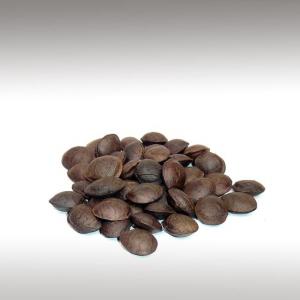
SACHA INCHI SEED OIL (PLUKENETIA VOLUBILIS LINNEO) - BASE OILS

BASE / GENERAL DATA
Information submited: January 31, 2015 Modified: May 9, 2018 By: OperaDreamhouse
Plukenetia Volubilis, commonly known as Sacha Inchi, Sacha Peanut, Mountain Peanut or Inca-Peanut, is a perennial plant with somewhat hairy leaves, in the Euphorbiaceae. The Sacha Inchi plant is indigenous to the Peruvian Amazon Forest, and produces small nuts that are extremely rich in high quality, nutritious vegetable oil.
Peru is one of the ten most bio diverse countries in the world with eighty-four ecosystems and twenty-eight distinct climate zones. This biodiversity encapsulates an immense variety of plants and animals, many of which are still unknown to man.
This plant is cultivated mainly in the district of Pichanaqui (Junin - Peru) at the heart of the Inca culture, because this land offers the best environmental conditions (the ground is soft and has a high content of minerals and some nutrients).
In the Amazon Rainforest in Peru, it has been cultivated by indigenous people for centuries. It grows better in acidic soils and alluvial flats near rivers. The plant reaches a height of 2 m, with alternate, heart shaped, serrated leaves.
The fruits are capsules of 3 to 5 cm in diameter with 4 to 7 points, are green and ripen blackish brown. On ripening, the fruits contain a soft black wet pulp that is messy and inedible, so are normally left to dry on the plant before harvest.
By two years of age, often up to a hundred dried fruits can be harvested at a time, giving 400 to 500 seeds a few times a year. Fruit capsules usually consist of four to five lobes, but some may have up to seven. Inside are the seeds, oval, dark-brown.
Sacha Inchi has been cultivated and used as a food source for 3,000 years in the Amazon rainforest.The Incas represented Sacha Inchi seed in their ceramics.
The fruit that these seeds grow in is inedible, but when lightly roasted with low heat the seeds take on a crisp nutty flavor.
Chancas Indians and other tribal groups of the region extract oil from the seeds which is used for the preparation of various meals. Sacha Inchi seed has a high oil content - more than 50% - more oil can be obtained therefore, more omega - 3.
The oil is extracted by simple cold pressing and does not require refining.
Current scientific studies indicate that the Inca Inchi is the best oil plant because of its composition and high nutritional quality. Often marketed as a "Superfood" Sacha Inchi is said to offer a variety of health benefits.
Chemical structure:
The seeds of Inchi have high protein (27%) and oil (35 - 60%) content, and the oil is rich in the essential fatty acids omega - 3 linolenic acid(45 - 53% of total fat content) and omega - 6 linoleic acid (34 - 39% of fat content), as well as non-essential omega - 9 (6 - 10% of fat content). They are also rich in iodine, vitamin A and vitamin E.
Sacha Inchi oil is valued as a nutritional supplement because it contains a high concentration of polyunsaturated fatty acids, making it an excellent source for omega - 3 and Omega - 6. It contains no cholesterol.
Peru is one of the ten most bio diverse countries in the world with eighty-four ecosystems and twenty-eight distinct climate zones. This biodiversity encapsulates an immense variety of plants and animals, many of which are still unknown to man.
This plant is cultivated mainly in the district of Pichanaqui (Junin - Peru) at the heart of the Inca culture, because this land offers the best environmental conditions (the ground is soft and has a high content of minerals and some nutrients).
In the Amazon Rainforest in Peru, it has been cultivated by indigenous people for centuries. It grows better in acidic soils and alluvial flats near rivers. The plant reaches a height of 2 m, with alternate, heart shaped, serrated leaves.
The fruits are capsules of 3 to 5 cm in diameter with 4 to 7 points, are green and ripen blackish brown. On ripening, the fruits contain a soft black wet pulp that is messy and inedible, so are normally left to dry on the plant before harvest.
By two years of age, often up to a hundred dried fruits can be harvested at a time, giving 400 to 500 seeds a few times a year. Fruit capsules usually consist of four to five lobes, but some may have up to seven. Inside are the seeds, oval, dark-brown.
Sacha Inchi has been cultivated and used as a food source for 3,000 years in the Amazon rainforest.The Incas represented Sacha Inchi seed in their ceramics.
The fruit that these seeds grow in is inedible, but when lightly roasted with low heat the seeds take on a crisp nutty flavor.
Chancas Indians and other tribal groups of the region extract oil from the seeds which is used for the preparation of various meals. Sacha Inchi seed has a high oil content - more than 50% - more oil can be obtained therefore, more omega - 3.
The oil is extracted by simple cold pressing and does not require refining.
Current scientific studies indicate that the Inca Inchi is the best oil plant because of its composition and high nutritional quality. Often marketed as a "Superfood" Sacha Inchi is said to offer a variety of health benefits.
Chemical structure:
The seeds of Inchi have high protein (27%) and oil (35 - 60%) content, and the oil is rich in the essential fatty acids omega - 3 linolenic acid(45 - 53% of total fat content) and omega - 6 linoleic acid (34 - 39% of fat content), as well as non-essential omega - 9 (6 - 10% of fat content). They are also rich in iodine, vitamin A and vitamin E.
Sacha Inchi oil is valued as a nutritional supplement because it contains a high concentration of polyunsaturated fatty acids, making it an excellent source for omega - 3 and Omega - 6. It contains no cholesterol.

SPIRITUAL PRACTISES DATA

MEDICINE / HEALTH DATA

BEAUTY / COSMETICS DATA

FOOD / COOKING DATA
COMMENTS
No comments.


